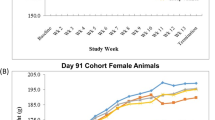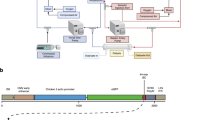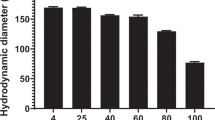Abstract
The development of a safe and reproducible gene delivery system is an essential step toward the clinical application of the hydrodynamic gene delivery (HGD) method. For this purpose, we have developed a novel electric power-driven injection system called the HydroJector-EM, which can replicate various time–pressure curves preloaded into the computer program before injection. The assessment of the reproducibility and safety of gene delivery system in vitro and in vivo demonstrated the precise replication of intravascular time–pressure curves and the reproducibility of gene delivery efficiency. The highest level of luciferase expression (272 pg luciferase per mg of proteins) was achieved safely using the time–pressure curve, which reaches 30 mm Hg in 10 s among various curves tested. Using this curve, the sustained expression of a therapeutic level of human factor IX protein (>500 ng ml−1) was maintained for 2 months after the HGD of the pBS-HCRHP-FIXIA plasmid. Other than a transient increase in liver enzymes that recovered in a few days, no adverse events were seen in rats. These results confirm the effectiveness of the HydroJector-EM for reproducible gene delivery and demonstrate that long-term therapeutic gene expression can be achieved by automatic computer-controlled hydrodynamic injection that can be performed by anyone.
This is a preview of subscription content, access via your institution
Access options
Subscribe to this journal
Receive 12 print issues and online access
$259.00 per year
only $21.58 per issue
Buy this article
- Purchase on Springer Link
- Instant access to full article PDF
Prices may be subject to local taxes which are calculated during checkout





Similar content being viewed by others
References
The Journal of Gene Medicine. Gene therapy clinical trials worldwide. http://www.wiley.com/legacy/wileychi/genmed/clinical/ (accessed on 28 August 2012).
Liu F, Song Y, Liu D . Hydrodynamics-based transfection in animals by systemic administration of plasmid DNA. Gene Therapy 1999; 6: 1258–1266.
Zhang G, Budker V, Wolff JA . High levels of foreign gene expression in hepatocytes after tail vein injections of naked plasmid DNA. Hum Gene Ther 1999; 10: 1735–1737.
Suda T, Liu D . Hydrodynamic gene delivery: its principles and applications. Mol Ther 2007; 15: 2063–2069.
Herweijer H, Wolff JA . Gene therapy progress and prospects: hydrodynamic gene delivery. Gene Therapy 2007; 14: 99–107.
Kamimura K, Liu D . Physical approaches for nucleic acid delivery to liver. AAPS J 2008; 10: 589–595.
Kamimura K, Suda T, Zhang G, Liu D . Advances in gene delivery systems. Pharm Med 2011; 25: 293–306.
Bonamassa B, Hai L, Liu D . Hydrodynamic gene delivery and its applications in pharmaceutical research. Pharm Res 2011; 28: 694–701.
Suda T, Gao X, Stolz DB, Liu D . Structural impact of hydrodynamic injection on mouse liver. Gene Therapy 2007; 14: 129–137.
Zhang G, Song YK, Liu D . Long-term expression of human alpha1-antitrypsin gene in mouse liver achieved by intravenous administration of plasmid DNA using a hydrodynamics-based procedure. Gene Therapy 2000; 7: 1344–1349.
Zhang G, Gao X, Song YK, Vollmer R, Stolz DB, Gasiorowski JZ et al. Hydroporation as the mechanism of hydrodynamic delivery. Gene Therapy 2004; 11: 675–682.
Zhou T, Kamimura K, Zhang G, Liu D . Intracellular gene transfer in rats by tail vein injection of plasmid DNA. AAPS J 2010; 12: 692–698.
Eastman SJ, Baskin KM, Hodges BL, Chu Q, Gates A, Dreusicke R et al. Development of catheter-based procedures for transducing the isolated rabbit liver with plasmid DNA. Hum Gene Ther 2002; 13: 2065–2077.
Yoshino H, Hashizume K, Kobayashi E . Naked plasmid DNA transfer to the porcine liver using rapid injection with large volume. Gene Therapy 2006; 13: 1696–1702.
Alino SF, Herrero MJ, Noguera I, Dasi F, Sanchez M . Pig liver gene therapy by noninvasive interventionist catheterism. Gene Therapy 2007; 14: 334–343.
Fabre JW, Grehan A, Whitehorne M, Sawyer GJ, Dong X, Salehi S et al. Hydrodynamic gene delivery to the pig liver via an isolated segment of the inferior vena cava. Gene Therapy 2008; 15: 452–462.
Kamimura K, Suda T, Xu W, Zhang G, Liu D . Image-guided, lobe-specific hydrodynamic gene delivery to swine liver. Mol Ther 2009; 17: 491–499.
Kamimura K, Guisheng Z, Liu D . Image-guided, intravascular hydrodynamic gene delivery to skeletal muscle in pigs. Mol Ther 2010; 18: 93–100.
Herrero MJ, Sabater L, Guenechea G, Sendra L, Montilla AI, Abargues R et al. DNA delivery to ‘ex vivo’ human liver segments. Gene Therapy 2012; 9: 504–512.
Suda T, Suda K, Liu D . Computer-assisted hydrodynamic gene delivery. Mol Ther 2008; 16: 1098–1104.
Miao CH, Thompson AR, Loeb K, Ye X . Long-term and therapeutic-level hepatic gene expression of human factor IX after naked plasmid transfer in vivo. Mol Ther 2001; 3: 947–957.
Miao CH, Ye X, Thompson AR . High-level factor VIII gene expression in vivo achieved by nonviral liver-specific gene therapy vectors. Hum Gene Ther 2003; 14: 1297–1305.
Miao CH, Brayman AA, Loeb KR, Ye P, Zhou L, Mourad P et al. Ultrasound enhances gene delivery of human factor IX plasmid. Hum Gene Ther 2005; 16: 893–905.
Tuddenham E . Gene therapy for haemophilia B. Haemophilia 2012; 18 (Suppl 4): 13–17.
Benveniste O . Gene therapy, an ongoing revolution. Blood 2012; 119: 2973–2974.
Brunetti-Pierri N, Liou A, Patel P, Palmer D, Grove N, Finegold M et al. Balloon catheter delivery of helper-dependent adenoviral vector results in sustained, therapeutic hFIX expression in Rhesus macaques. Mol Ther 2012; 20: 1863–1870.
Schuttrumpf J, Milanov P, Abriss D, Roth S, Tonn T, Seifried E . Transgene loss and changes in the promoter methylation status as determinants for expression duration in nonviral gene transfer for factor IX. Hum Gene Ther 2011; 22: 101–106.
Scott DW, Lozier JN . Gene therapy for haemophilia: prospects and challenges to prevent or reverse inhibitor formation. Br J Haematol 2012; 156: 295–302.
Vollmar B, Menger MD . The hepatic microcirculation: mechanistic contributions and therapeutic targets in liver injury and repair. Physiol Rev 2009; 89: 1269–1339.
Brunetti-Pierri N, Stapleton GE, Law M, Breinholt J, Palmer DJ, Zuo Y et al. Efficient, long-term hepatic gene transfer using clinically relevant HDAd doses by balloon occlusion catheter delivery in nonhuman primates. Mol Ther 2009; 17: 327–333.
Vrekoussis T, Chaniotis V, Navrozoglou I, Dousias V, Pavlakis K, Stathopoulos EN et al. Image analysis of breast cancer immunohistochemistry-stained sections using ImageJ: an RGB-based model. Anticancer Res 2009; 29: 4995–4998.
Acknowledgements
This work was supported in part by JSPS Grants 22890064, 23790595, The Sumitomo Foundation Grant 100033 and Takeda Science Foundation Grant to KK. The authors acknowledge Takao Tsuchida, Division of Gastroenterology and Hepatology, Niigata University, for his excellent assistance for histological stainings. The authors would like to thank Nobuyoshi Fujisawa, Minoru Tanaka and all staff members in Division of Laboratory Animal Resources in Niigata University for the excellent assistance for animal care. We thank Enago for the English language review.
Author information
Authors and Affiliations
Corresponding author
Ethics declarations
Competing interests
The authors declare no conflict of interest.
Additional information
Supplementary Information accompanies the paper on Gene Therapy website
Supplementary information
Rights and permissions
About this article
Cite this article
Yokoo, T., Kamimura, K., Suda, T. et al. Novel electric power-driven hydrodynamic injection system for gene delivery: safety and efficacy of human factor IX delivery in rats. Gene Ther 20, 816–823 (2013). https://doi.org/10.1038/gt.2013.2
Received:
Revised:
Accepted:
Published:
Issue Date:
DOI: https://doi.org/10.1038/gt.2013.2
Keywords
This article is cited by
-
Effective Prevention of Liver Fibrosis by Liver-targeted Hydrodynamic Gene Delivery of Matrix Metalloproteinase-13 in a Rat Liver Fibrosis Model
Molecular Therapy - Nucleic Acids (2016)
-
Effects of Fibrotic Tissue on Liver-targeted Hydrodynamic Gene Delivery
Molecular Therapy - Nucleic Acids (2016)
-
High and prolonged sulfamidase secretion by the liver of MPS-IIIA mice following hydrodynamic tail vein delivery of antibiotic-free pFAR4 plasmid vector
Gene Therapy (2014)
-
Hemodynamics of a hydrodynamic injection
Molecular Therapy - Methods & Clinical Development (2014)



